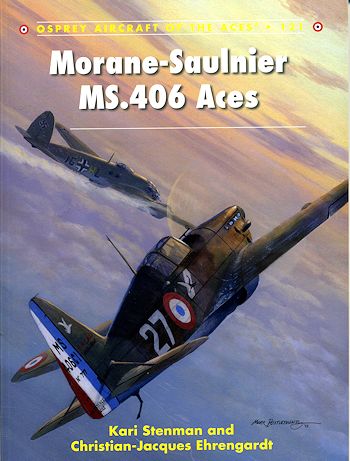 An aircraft
that was bordering on obsolescence at the start of WWII was the M.S. 406. It was
a capable flyer, easy to handle and with virtually no vices, yet it was
superceded by the newest fighters of the Luftwaffe, the Bf-109E and Bf-110C. One
of its few faults, aside from the lack of armor plating and self sealing fuel
tanks, was the propensity of the guns to freeze at the altitude where most
combat took place. This was not good. It also had no landing gear locking
mechanism, so hard turns often caused the gear to deploy.
An aircraft
that was bordering on obsolescence at the start of WWII was the M.S. 406. It was
a capable flyer, easy to handle and with virtually no vices, yet it was
superceded by the newest fighters of the Luftwaffe, the Bf-109E and Bf-110C. One
of its few faults, aside from the lack of armor plating and self sealing fuel
tanks, was the propensity of the guns to freeze at the altitude where most
combat took place. This was not good. It also had no landing gear locking
mechanism, so hard turns often caused the gear to deploy.
Developed from the MS 405 of 1935 the French had a
modern fighter that was equal to the Hurrican and Jumo powered 109s. However,
the Hispano-Suiza engine was not capable of the sort of power that was provided
by the Spitfires and later 109s. The MS 406 was also time consuming to build and
rather expensive. However, one fights with what one has at the time and so it
was that most French fighter units went into combat with the MS 406.
Thanks to its rifle caliber main guns, bringing down
enemy planes was not all that easy. Frequently several fighters had to combine
their firepower to bring down a German bomber. Sure, it had a central 'motor
canon', but apparently this gun was not that effective or jammed rather easily.
Still, there were pilots who were able to either reach ace status or started on
their careers to acedom flying the 406.
After the armistice, no French fighter units in
Metropolitan France or in Algeria flew the MS 406. It had pretty well been
relegated to the training role, though Vichy forces did send some to Syria,
Madagascar and to French Indo-China where they were used against the British,
Japanese and Thai air forces, albeit somewhat briefly. Some success was obtained
in those theaters, though more often the 406 was the victim.
An area where the MS 406 saw a lot of success was in the
hands of the Finnish Air Force. When the Soviets invaded during the Winter War,
the need for fighter planes was great. France promised well over a hundred MS
406s and other types, but only actually delivered 30 planes, which were used
during the closing days of that conflict. After France surrendered, many more
planes were purchased from the war booty captured by the Germans in exchange for
access to northern Norway by the German Army through Finnish territory. These
extra aircraft were quite welcome and allowed the Finns to add to their defenses
during the Continuation War. Though obsolescent, they proved to be quite rugged
and were often more than a match for Soviet aircraft. Always low on power, the
type was re-engined by the Finns with captured Soviet M-105 engines gleaned from
the many shot down Soviet aircraft. This resulted in the much improved
(performance-wise) Moko Moraine, which saw service until the end of hostilities.
In line with other books in this series, there are a ton
of well done period photographs as well as the usual large center section of
full color profiles of the planes that were flown by units during the war. We
also get the usual mission stories to spice things up, one of
the major attractions of this series. In the appendices is a listing of aces and
their scores. An excellent read and a great reference book for the fan of this
French fighter.
May 2014
For more on the complete line of Osprey books,
visit www.ospreypublishing.com. In the US, it is
Osprey Direct at 44-02 23rd St, Suite 219, Long Island City, NY 11101., where you can
get a catalogue of available books.
If you would like your product reviewed fairly and quickly, please
contact
me or see other details in the
Note to
Contributors.
 An aircraft
that was bordering on obsolescence at the start of WWII was the M.S. 406. It was
a capable flyer, easy to handle and with virtually no vices, yet it was
superceded by the newest fighters of the Luftwaffe, the Bf-109E and Bf-110C. One
of its few faults, aside from the lack of armor plating and self sealing fuel
tanks, was the propensity of the guns to freeze at the altitude where most
combat took place. This was not good. It also had no landing gear locking
mechanism, so hard turns often caused the gear to deploy.
An aircraft
that was bordering on obsolescence at the start of WWII was the M.S. 406. It was
a capable flyer, easy to handle and with virtually no vices, yet it was
superceded by the newest fighters of the Luftwaffe, the Bf-109E and Bf-110C. One
of its few faults, aside from the lack of armor plating and self sealing fuel
tanks, was the propensity of the guns to freeze at the altitude where most
combat took place. This was not good. It also had no landing gear locking
mechanism, so hard turns often caused the gear to deploy.